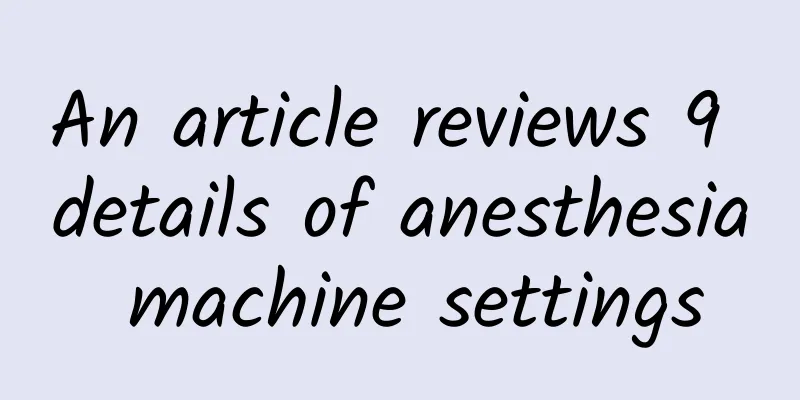An article reviews 9 details of anesthesia machine settings

|
The anesthesia machine is what anesthesiologists come into contact with most during anesthesia work. Now let’s learn the basic settings of the anesthesia machine with my colleagues. During anesthesia, the most important function of the anesthesia machine is to control breathing during general anesthesia. For anesthesiologists, there are two most commonly used ways to control breathing: Volume control mode (VCV), that is, the ventilator ventilates at a preset volume, and the tidal volume is constant to ensure the minute ventilation, which is commonly used in adults; Pressure-controlled ventilation (PCV) means that the ventilator ventilates at a preset airway pressure. The pressure is constant and lung barotrauma is less likely to occur. It is commonly used in children and adults with bullae and pneumothorax. 1. Oxygen concentration: 40%-50%, adjustable at any time according to oxygen saturation; 2. Tidal volume: generally set at 6-8 mL/kg; 3. Respiratory rate: 35-45 mmHg according to end-tidal carbon dioxide; 4. Inhalation/expiration time ratio: 1:2-1:3. Inverse ratio ventilation (IRV) is a ventilation method that prolongs the inspiratory time. The I/E of conventional ventilation CMV is 1:2 or 1:3, while the I/E of inverse ratio ventilation is generally set between 1.1:1 and 1.7:1, and can reach up to 4:1, and the end-inspiratory pause (EIP) or low-level PEEP/CPAP can be used at the same time. The characteristic of inverse ratio ventilation is prolonged inspiratory time, and its mechanism is similar to PEEP. Its advantages are improved oxygenation and increased carbon dioxide excretion. Due to increased FRC, alveolar collapse can be prevented, lung compliance can be increased, and ventilation resistance can be reduced. The disadvantages of inverse ratio ventilation are that it can increase mean airway pressure, reduce cardiac output, and increase the chance of pulmonary barotrauma. Oxygen delivery needs to be monitored during use, and it is generally limited to patients with no spontaneous breathing. Obstructive ventilation disorder is characterized by a decrease in flow rate indicators, such as FEV1/FVC, which is mainly seen in chronic obstructive pulmonary disease, bronchial asthma, etc.) and can be adjusted to 1:3 or a longer exhalation time. Restrictive ventilation disorder ( restrictive refers to limited alveolar expansion during inhalation, causing alveolar hypoventilation , mainly characterized by a decrease in lung capacity, such as vital capacity, which is more common in diseases such as interstitial pulmonary fibrosis, chest deformity, pleural effusion, etc.) can be adjusted to 1:1. 5.Tpause: The breath-holding time is part of the inhalation time, which generally does not exceed 20% of the respiratory cycle. One respiratory cycle is about 3-5 seconds. 6. Air delivery time = inhalation time + breath holding time. 7.PEEP: Positive end-expiratory pressure (PEEP) refers to the inhalation triggered by the patient's spontaneous breathing or generated by the ventilator, and the end of exhalation is made with the help of a flow-limiting valve device installed at the exhalation end, so that the airway pressure is higher than the atmospheric pressure. PEEP can expand the collapsed alveoli, increase the functional residual capacity (FRC) and lung compliance, improve ventilation and oxygenation, and reduce intrapulmonary shunt. It is one of the important means to treat hypoxemia. However, PEEP increases intrathoracic pressure (ITP) and affects cardiovascular function. In clinical applications, the optimal PEEP should be selected to reduce the impact on circulatory function. The concept of optimal PEEP is the PEEP level with the best lung compliance, expansion of collapsed alveoli, highest oxygen partial pressure, minimum intrapulmonary shunt and maximum oxygen delivery, while having the least impact on cardiac output. 8. The normal tracheal mucosal arterial perfusion pressure in adults is 4.0 kPa (40.8 cmH 2 O). Therefore, the cuff pressure should be 4.0 kPa (40.8 cmH 2 O) lower than the capillary perfusion pressure. 9. Inspiratory plateau pressure is the pressure when holding the breath after inspiration. If the breath-holding time is long enough (10% or more of the respiratory cycle), the plateau pressure can reflect the alveolar pressure during inspiration, and the normal value is 5~13cmH2O. During mechanical ventilation, efforts should be made to keep the peak airway pressure no more than 40cmH2O, and the plateau pressure <30~35cmH2O. If it is higher than this value, the incidence of barotrauma will increase significantly. In recent years, it is believed that monitoring the plateau pressure can better reflect the danger of barotrauma than the peak airway pressure, because the peak airway pressure mainly acts on the airway, while the plateau pressure truly reflects the maximum pressure in the alveoli. Excessive plateau pressure and excessive inhalation time also increase the load on the blood circulation in the lungs. Li Yuan, Department of Anesthesiology, Baoding Maternal and Child Health Hospital [Warm Tips] Follow us, there are a lot of professional medical knowledge here, revealing the secrets of surgical anesthesia for you~ |
<<: If a gallbladder polyp of 1 cm is not treated with surgery, what are the precautions?
Recommend
Anger & Depression! Who is the culprit behind this?
Author: Zhao Xumao (Institute of Zoology, Chinese...
How to recover from hemorrhoids after vaginal delivery
Hemorrhoids are a very painful disease. Hemorrhoi...
Is ovarian care in a beauty salon useful?
Currently, many beauty salons on the market have ...
Why do women sweat when they sleep at night? How can they treat it?
Women have more physical problems than men, and w...
Is it normal to not see the gestational sac at 6 weeks of pregnancy?
In the early stages of pregnancy, B-ultrasound ca...
Why do girls have black nipples?
Changes in the breasts will make many ignorant gi...
Where does lamb chop come from? What are the benefits of eating lamb chop?
When it comes to lamb chops, many people drool ju...
Can I eat cookies during early pregnancy?
Many people like to eat a variety of delicacies i...
How to extract teeth during orthodontic treatment?
Many people have heard that orthodontic treatment...
What are the characteristics of a woman who is gentle on the outside but strong on the inside?
Each type of person has different personality tra...
Can girls soak their feet during their period?
If you are tired after a day's work, would yo...
What should I prepare before getting pregnant?
Every parent loves their child very much. This lo...
What are the symptoms of uterine cold in women?
Many female friends may not realize that they hav...
How about ultrasound examination of ovarian cysts?
According to statistics, many people in the count...









